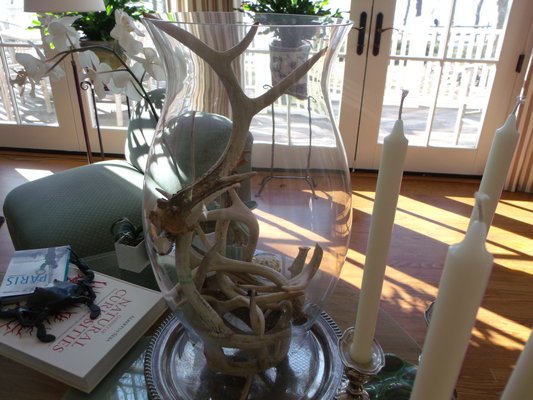
The shores of Big Fresh Pond, also known as Missapogue, between Tuckahoe and North Sea, seem to beckon visitors to walk there. The 64-acre freshwater lake is a frequent destination for bird watchers and nature lovers both local and from away. It is home to many species of fish and “some really large turtles,” said Roger Blaugh with a laugh.Mr. Blaugh and Michael Forestano share a Corcoran office in Southampton and a home on Big Fresh Pond, and Mr. Forestano in particular enjoys strolls through the woods and down by the water.
He also enjoys collecting some of the more interesting artifacts that pop up in front of him—one of the more recent being an enormous nest, most likely constructed by paper wasps or hornets.
“I was told that the wasps build these huge nests, but they only inhabit them for one season,” Mr. Forestano said. “Then they hibernate, or die off, or move on.” He waited until the nest had been naturally vacated, and then, with the help of a professional, removed the curio from the tree.
It was then that his life partner, and business partner, Roger Blaugh, sprang into action. A collector of furniture from the William IV era—a brief period of design between the simpler lines of the neoclassical style and the Gothic excessiveness of the Victorian era—Mr. Blaugh pored over antiques auction websites until he found the perfect showcase.
“The nest was in a big box in the basement,” Mr. Blaugh said. “We didn’t want to squish it.” The two measured the dimensions of the box and felt that the display would be perfect.
And now the nest, once home to thousands of buzzing insects, has found a home of its own.
The “objet display” has an ebony exterior with a mahogany interior, and fits the nest to a T. “We thought we might have to trim the branch a little,” Mr. Forestano said. “But it was a perfect fit.”
“We were so excited,” said Mr. Blaugh.
Mr. Blaugh added to the display with autumn leaves, faux fungi from a craft store, and even a few butterflies which had already joined the choir invisible by the time Mr. Forestano found them on the property.
It was extremely popular during the 18th and early 19th centuries for people to wander and collect “botanicals and natural artifacts” to display in their homes, Mr. Forestano explained. Whether the collections were feathers, bones, teeth, shells or taxidermy, they were often showcased under cloche, or bell, domes, or in cabinets similar to the one on Big Fresh Pond.
Following the voyage of Darwin’s Beagle, Europeans and Americans alike were seized with the desire to discover nature on their own. The children’s author and illustrator Beatrix Potter was an amateur mycologist, studying and collecting mushrooms to exhibit proudly in her home, along with insects and fossils. A doctor in Edinburgh, Robert Edmond Grant, had one of the largest collections of invertebrates in the world, and campaigned vigorously to have these “cabinets of curiosities,” some of which overran mansions of the Victorian age, to be property catalogued and curated. This led to the basis of many of today’s natural history museums.
In keeping with the water-and-woods theme of their home, Mr. Forestano and Mr. Blaugh also have a collection of coral, some of which sits like black winter branches on either side of the fireplace mantel. A bird nest—“also vacated,” Mr. Forestano is quick to inform—is exhibited in glass, with branches and leaves and other objects to add to the feel of a true museum display. Enormous vases hold shells rather than flowers, antlers abound, and a vase-like piece of sponge, several feet tall, cradles an ostrich egg in its interior.
Perhaps it’s in his nature because of his name, but Mr. Forestano waxes poetic when talking of his strolls around the woods. “It’s a peaceful time to go down to the lake during the day, or when the sun starts to set,” he said. Sometimes he just finds “unique branches” with an interesting constellation of acorns, to bring a bit more of the outdoors to the indoors.
Looking back at the impressive wasp nest, Mr. Blaugh smiled. “It makes a great conversation piece,” he said.